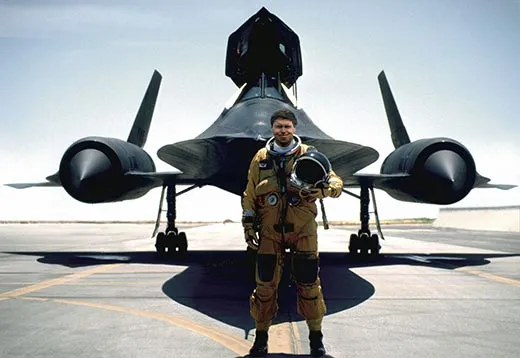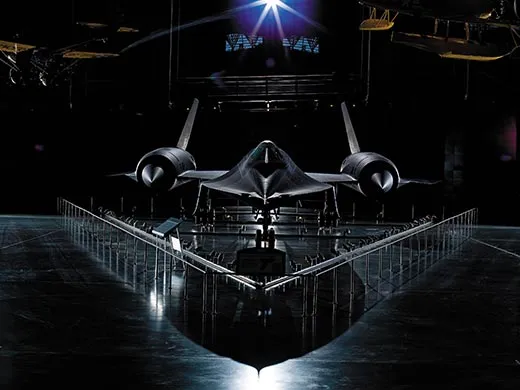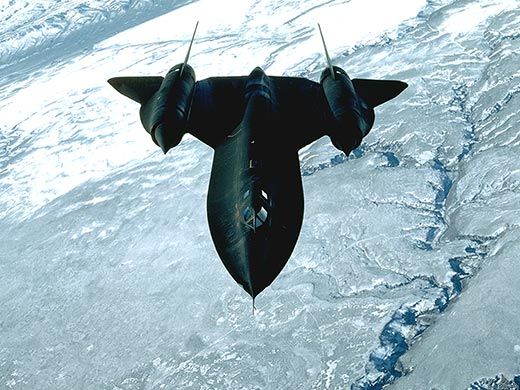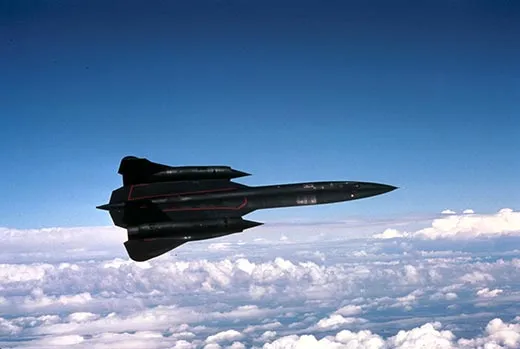The Ultimate Spy Plane
The SR-71 Blackbird, now featured in the Transformers movie sequel, was faster than a rifle bullet and flew 16 miles above the earth
/https://tf-cmsv2-smithsonianmag-media.s3.amazonaws.com/filer/SR-71-631.jpg)
In the new sci-fi movie Transformers: Revenge of the Fallen, an airplane on display at the Smithsonian's Udvar-Hazy Center in Chantilly, Virginia, gets a star turn. The real-life reconnaissance plane, an SR-71 Blackbird, is the basis for the character Jetfire, a souped-up superplane brought to life by the film's animators. (The Transformers franchise recounts a series of epic battles between two factions of alien robots who disguise themselves by morphing into machines.)
Of course, the actual SR-71 Blackbird had transformed manned flight long before special-effects animators saw its potential. Created as the ultimate spy plane, the SR-71, which first took to the air in December 1964, flew reconnaissance missions until 1990, capable of hurtling along at more than Mach 3, about 2,280 miles per hour—faster than a rifle bullet—at 85,000 feet, or 16 miles above the earth. It is the fastest jet-powered airplane ever built. At top speeds, the surface heat of the airframe could reach 900 degrees Fahrenheit. In their pressurized suits and breathing pure oxygen—mandated by the extreme altitude—the two-man crew looked like astronauts.
Brian Shul, one of fewer than a hundred pilots who flew the plane on recon missions from Beale Air Force base in California as well as bases in England and Japan, calls the SR-71 simply "the most remarkable airplane of the 20th century. We'll never see a plane like that again."
The Udvar-Hazy Blackbird, identified by its tail number, 61-7972, holds several records, including: New York to London in 1 hour 54 minutes 56.4 seconds. (Another Blackbird, 61-7958, set the record for average jet speed: 2,193.167 mph.) On March 6, 1990, as it made its final flight, the Smithsonian plane set another record—Los Angeles to Dulles International Airport, outside Washington, D.C., in 1 hour 4 minutes 20 seconds (barely time for a snack and a snooze). That day, a team including Air Force Lt. Col. Ed Yeilding and Lt. Col. Joseph Vida touched the plane down at Dulles for delivery to Udvar-Hazy, the National Air and Space Museum's companion facility.
I asked Shul, a former Air Force fighter pilot and Vietnam veteran who has written two books about the Blackbird—one recounting his reconnaissance for a dramatic raid on Libya in 1986—what it was like to fly such a phenomenal craft. "It wasn't like any other airplane," he told me. "It was terrifying, exciting, intense and humbling every time you flew. Each mission was designed to fly at a certain speed; you always knew the airplane had more. It was like driving to work in a double-A fuel dragster."
A team of engineers and designers at a southern California unit of Lockheed, headed by legendary aeronautical designer Clarence "Kelly" Johnson and his eventual successor, Benjamin Rich, created the SR-71. To deal with airframe heat at Mach 3 and to reduce weight, the SR-71's skin is 85 percent titanium and 15 percent carbon composites. Ironically—because the spy plane was a creature of the cold war—its titanium was purchased from the Soviet Union, although the use to which it would be put remained a closely guarded secret.
The unarmed Blackbird depended on its speed and altitude for defense and on a high degree of invisibility. The plane's distinctive flat profile, with a sharp edge, or chine, running the length of the fuselage, presented very little surface to be detected by radar. Its features anticipated the F-117A stealth fighter, developed at the same Lockheed unit. The SR-71's unusual silhouette caused workers at a U.S. base in Okinawa, Japan, to refer to the plane as the habu—a poisonous black snake indigenous to the island. Crews dubbed the plane the "sled"; SR-71 enthusiasts call themselves "Sledheads."
Achieving Mach 3 performance is expensive. The 32 Blackbirds cost an average of $34 million each. Of the billion-dollar SR-71 fleet, 12 were in accidents, but none was shot down by hostile action. Only one crew member was killed, in a mishap that occurred during a midair refueling. "We knew," says Shul of his fellow Blackbird pilots, "that we were flying a piece of history."
And history the planes have become. However advanced they were, time and technology overtook them; in 1990, as satellites appropriated their mission, operational flights ended. Today's unmanned orbital droids may represent the state of the art. But compared with the Blackbird, they are hardly art at all.
Owen Edwards is a freelance writer and author of the book Elegant Solutions
/https://tf-cmsv2-smithsonianmag-media.s3.amazonaws.com/accounts/headshot/Owen-Edwards-240.jpg)





/https://tf-cmsv2-smithsonianmag-media.s3.amazonaws.com/accounts/headshot/Owen-Edwards-240.jpg)